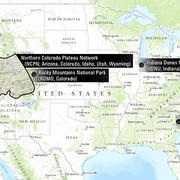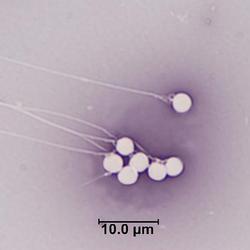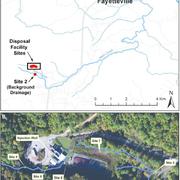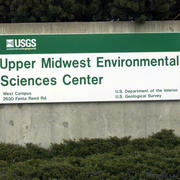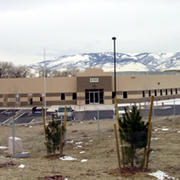Due to a lapse in appropriations, the majority of USGS websites may not be up to date and may not reflect current conditions. Websites displaying real-time data, such as Earthquake and Water and information needed for public health and safety will be updated with limited support. Additionally, USGS will not be able to respond to inquiries until appropriations are enacted. For more information, please see www.doi.gov/shutdown
Toxic Substances Hydrology Program
Home
Programs L2 Landing Page
Toxic Substances Hydrology Program scientists develop and apply advanced analytical methods, field investigations, laboratory studies, and modeling capabilities to understand sources, movement, and exposure pathways of chemical and microbial contaminants in the environment. They work jointly with Contaminant Biology Program Scientists who then determine the toxicity and effects of contaminants.
USGS Environmental Health Science, led by the Contaminant Biology and theToxic Substances Hydrology Programs, supports specialized teams of scientists who develop and apply advanced laboratory methods and field investigations to understand how contaminants and pathogens enter and move through the environment and affect the health of insects, fish, wildlife, and domestic animals.
Understanding Drivers of Cyanotoxin Production in the Lake Okeechobee Waterway
The U.S. Geological Survey (USGS) and other researchers combined field and laboratory approaches in two studies to understand the factors that drive cyanobacterial bloom development and associated cyanotoxin production in Lake Okeechobee, the St. Lucie River and Estuary, and the Indian River Lagoon in response to the large-scale Lake Okeechobee cyanobacteria bloom in 2016.
Is Uranium in Water Resources near the Grand Canyon a Health Hazard?
The public worries that uranium in natural geologic formations, mine tailings, dusts, water, and other geologic materials can pose a health hazard to humans and wildlife.
Our specialized teams of hydrologists, chemists, and geologists working together at a field site in the Grand Canyon region of the United States have shown:
Elevated uranium concentrations (above the drinking...
Can There be Unintended Benefits when Wastewater Treatment Infrastructure is Upgraded?
Science from the U.S. Geological Survey (USGS) and other entities has shown that a mixture of natural and synthetic estrogens and other similar chemicals are discharged from wastewater treatment plants (WWTPs) to streams and rivers.
USGS and University of Colorado hydrologists, chemists, geologists, and biologists studied the chemistry and biology of Boulder Creek downstream of Boulder ...
Are Spills from Swine Lagoons Causing Downstream Health Hazards?
There are no national databases or tracking of the number or frequency of manure spills in the United States. Some past spills have been shown to result from events such as equipment failures, over-application of manure to agricultural fields, runoff from open feedlots, storage overflow, accidents with manure transporting equipment, severe weather events, or possibly deliberate actions....
What Are the Health Hazards from Contaminants Released to the Environment by Natural Disasters?
Our specialized teams of hydrologists, chemists, and geologists working together at field sites in Northeastern US after Hurricane Sandy have shown:
- Metal contaminants were released to the environment after Hurricane Sandy due to some dune restoration activities.
- In other locations the storm actually decreased contaminant exposures to bottom dwelling aquatic biota. ...
Are Naturally Occurring Microbiological Toxins in Water Resources a Health Hazard?
A growing number of human gastrointestinal, respiratory, dermatologic, and neurologic effects, as well as dog and livestock illnesses and deaths, in the United States have been linked to exposures to algal blooms in recreational lakes and stock ponds.
Some of the blooms contain cyanobacteria, which have the potential to produce cyanotoxins in freshwater systems. However, the connection...
What is the Chemical and Microbial Content of Our Tap Waters?
Safe Drinking Water Act compliance addresses the safety of public-supply water systems. The composition of public-supply drinking water is generally only tested at the treatment plant, and not at the tap after traveling through the water distribution system. Only lead and copper are tested at a subset of residential and other taps. Testing of water in private wells is rare unless local health...
Are Tumors in Wild Fish Harvested in the Great Lakes Region Related to Contaminants in Water Resources?
Our specialized teams of scientists are working in our laboratories and at field sites around the Great Lakes in collaboration with other federal and state resource agencies to document the prevalence of skin and liver tumors. Tumor prevalence in white suckers (Catostomus commersonii), a fish harvested as a food source by local communities, is related to the degree of urbanization in watershed...
Are Spills Associated with Deep Well Injection of Wastewater from Oil and Gas Operations a Health Hazard?
We have specialized teams of hydrologists, chemists, biologists, and geologists working together in the New River Gorge National River watershed to answer this question.
Wastewater generated in association with oil and gas operations at this site is managed by injection in deep wells designed to safely dispose and contain contaminants in deep geologic formations.
Contaminants...
Food Resources Science Team
Access to an adequate, safe, and sustainable food supply is one of the highest priorities for our society. Agricultural crop and livestock production often occur within the same landscapes. Their yields as well as pests, diseases, and other threats are effectively managed by using a variety of tools such as synthetic nutrients, pesticides, and veterinary pharmaceuticals. Best management...
Land Stewardship Science Team
Managers of federal lands (national parks and monuments, refuges, wildlands, etc.) need to use chemicals to deal with difficult issues such as stopping wildfires, controlling wildlife disease, and removing non-native plants and animals. Sometimes, using chemicals to deal with these issues has the potential to cause unintended consequences and unforeseen health impacts to both humans and other...
Minerals Science Team
Mineral mining is an essential part of a healthy economy. U.S. mines produced an estimated $75.2 billion in nonfuel minerals during 2017 including industrial minerals, aggregates, and metals. The mining industry and government regulators work to prevent the release of contaminants such as metals into the environment from mining activities. With interdisciplinary scientists in our laboratories...
Assessing Endocrine Disrupting Chemicals Risk In U.S. National Parks
Endocrine disrupting chemicals (EDC) threaten the reproductive success and long-term survival of sensitive aquatic populations in the U.S. National Park Service (NPS). The project employs a standardized EDC risk assessment framework to link new and ongoing research efforts in individual Parks and in Park Monitoring Networks, in order to provide a service-wide assessment of EDC risk in the NPS.
SCoRR Mapping Web Application
The Sediment-bound Contaminant Resiliency and Response (SCoRR) Mapping Application was developed to allow users to visualize and view information generated during this study. Additional datasets including Census data, the National Land Cover Database, and National Hydrography data are also provided for users to generate custom maps.
Future research needs involving pathogens in groundwater
Contamination of groundwater by enteric pathogens has commonly been associated with disease outbreaks. Proper management and treatment of pathogen sources are important prerequisites for preventing groundwater contamination. However, non-point sources of pathogen contamination are frequently difficult to identify, and existing approaches for...
Bradford, Scott A.; Harvey, Ronald W.Density-driven free-convection model for isotopically fractionated geogenic nitrate in sabkha brine
Subsurface brines with high nitrate (NO3−) concentration are common in desert environments as atmospheric nitrogen is concentrated by the evaporation of precipitation and little nitrogen uptake. However, in addition to having an elevated mean concentration of ∼525 mg/L (as N), NO3− in the coastal sabkhas of Abu Dhabi is enriched in 15N (mean δ15N...
Wood, Warren W.; Böhlke, John K.Geochemistry and hydrology of perched groundwater springs: assessing elevated uranium concentrations at Pigeon Spring relative to nearby Pigeon Mine, Arizona (USA)
The processes that affect water chemistry as the water flows from recharge areas through breccia-pipe uranium deposits in the Grand Canyon region of the southwestern United States are not well understood. Pigeon Spring had elevated uranium in 1982 (44 μg/L), compared to other perched springs (2.7–18 μg/L), prior to mining operations at the nearby...
Beisner, Kimberly R.; Paretti, Nicholas V.; Tillman, Fred; Naftz, David L.; Bills, Donald; Walton-Day, Katie; Gallegos, Tanya J.Improved vertical streambed flux estimation using multiple diurnal temperature methods in series
Analytical solutions that use diurnal temperature signals to estimate vertical fluxes between groundwater and surface water based on either amplitude ratios (Ar) or phase shifts (Δϕ) produce results that rarely agree. Analytical solutions that simultaneously utilize Ar and Δϕ within a single solution have more recently been derived, decreasing...
Irvine, Dylan J.; Briggs, Martin A.; Cartwright, Ian; Scruggs, Courtney R.; Lautz, Laura K.The removal kinetics of dissolved organic matter and the optical clarity of groundwater
Concentrations of dissolved organic matter (DOM) and ultraviolet/visible light absorbance decrease systematically as groundwater moves through the unsaturated zones overlying aquifers and along flowpaths within aquifers. These changes occur over distances of tens of meters (m) implying rapid removal kinetics of the chromophoric DOM that imparts...
Chapelle, Francis H.; Shen, Yuan; Strom, Eric W.; Benner, RonaldInvestigating dynamic sources of pharmaceuticals: Demographic and seasonal use are more important than down-the-drain disposal in wastewater effluent in a University City setting
Pharmaceutical pollution in surface waters poses risks to human and ecosystem health. Wastewater treatment facilities are primary sources of pharmaceutical pollutants, but little is known about the factors that affect drugs entering the wastewater stream. This paper investigates the effects of student pharmaceutical use and disposal behaviors and...
Vatovec, Christine; Phillips, Patrick J.; Van Wagoner, Emily; Scott, Tia-Marie; Furlong, Edward T.Effects of flow regime on metal concentrations and the attainment of water quality standards in a remediated stream reach, Butte, Montana
Low-flow synoptic sampling campaigns are often used as the primary tool to characterize watersheds affected by mining. Although such campaigns are an invaluable part of site characterization, investigations which focus solely on low-flow conditions may yield misleading results. The objective of this paper is to demonstrate this point and elucidate...
Runkel, Robert L.; Kimball, Briant A.; Nimick, David A.; Walton-Day, KatherineExposure to the contraceptive progestin, gestodene, alters reproductive behavior, arrests egg deposition, and masculinizes development in the fathead minnow (Pimephales promelas)
Endogenous progestogens and pharmaceutical progestins enter the environment through wastewater treatment plant effluent and agricultural field runoff. Lab studies demonstrate strong, negative exposure effects of these chemicals on aquatic vertebrate reproduction. Behavior can be a sensitive, early indicator of exposure to environmental...
Frankel, Tyler E.; Meyer, Michael T.; Kolpin, Dana W.; Gillis, Amanda B.; Alvarez, David A.; Orlando, Edward F.Molecular-level evidence provided by ultrahigh resolution mass spectrometry for oil-derived doc in groundwater at Bemidji, Minnesota
Dissolved organic matter samples extracted from ground water at the USGS Bemidji oil spill site in Minnesota were investigated by ultrahigh resolution mass spectrometry. Principle component analysis (PCA) of the elemental composition assignments of the samples showed that the score plots for the contaminated sites were well separated from those...
Islam, Ananna; Ahmed, Arif; Hur, Manhoi; Thorn, Kevin A.; Kim, SunghwanApplication of frequency- and time-domain electromagnetic surveys to characterize hydrostratigraphy and landfill construction at the Amargosa Desert Research Site, Beatty, Nevada
In 2014 and 2015, the U.S. Geological Survey (USGS), conducted frequency-domain electromagnetic (FDEM) surveys at the USGS Amargosa Desert Research Site (ADRS), approximately 17 kilometers (km) south of Beatty, Nevada. The FDEM surveys were conducted within and adjacent to a closed low-level radioactive waste disposal site located at the ADRS....
White, Eric A.; Day-Lewis, Frederick D.; Johnson, Carole D.; Lane, John W.Enabling science support for better decision-making when responding to chemical spills
Chemical spills and accidents contaminate the environment and disrupt societies and economies around the globe. In the United States there were approximately 172,000 chemical spills that affected US waterbodies from 2004 to 2014. More than 8000 of these spills involved non–petroleum-related chemicals. Traditional emergency responses or incident...
Weidhass, Jennifer L.; Dietrich, Andrea M.; DeYonker, Nathan J.; Dupont, R. Ryan; Foreman, William T. ; Gallagher, Daniel; Gallagher, Jennifer E. G.; Whelton, Andrew J.; Alexander, WilliamEnvironmental implications of the use of sulfidic back-bay sediments for dune reconstruction — Lessons learned post Hurricane Sandy
Some barrier-island dunes damaged or destroyed by Hurricane Sandy's storm surges in October 2012 have been reconstructed using sediments dredged from back bays. These sand-, clay-, and iron sulfide-rich sediments were used to make berm-like cores for the reconstructed dunes, which were then covered by beach sand. In November 2013, we sampled and...
Plumlee, Geoffrey S.; Benzel, William M.; Hoefen, Todd M.; Hageman, Philip L.; Morman, Suzette A.; Reilly, Timothy J.; Adams, Monique; Berry, Cyrus J.; Fischer, Jeffrey; Fisher, IreneExplore our science and investigations through photography and scientific imagery.
A USGS scientist prepares a sample to test the effect of antibiotics
A USGS scientist prepares a sample to test the effect of antibiotics on denitrifying bacteria within a glove box. A glove box allows scientists to work with samples in an anaerobic (no oxygen) atmosphere, the conditions under which denitrification occurs.
Using the 384-well plate format, a single zebrafish embryo is tested
Using the 384-well plate format, a single zebrafish embryo is tested in each well. This is an example of a 72 hour post fertilization fli1:egfp zebrafish (3 millimeters long) imaged under a fluorescein isothiocyanate (FITC) filter.
Molecular Devices ImageXpress† High-Content Imaging System
Molecular Devices ImageXpress† High-Content Imaging System
Molecular Devices ImageXpress† High-Content Imaging System
Molecular Devices ImageXpress† High-Content Imaging System that can generate more than 25,000 images in less than 5 hours of automated image acquisition.
(USGS scientist working on data analysis of cyanotoxins in water
U.S. Geological Survey (USGS) scientist working on data analysis of cyanotoxins in water samples
Keith A. Loftin is the lead scientist for algal and cyanobacteria
Keith A. Loftin, USGS, is the lead scientist for algal and cyanobacterial toxins
USGS scientists evaluating the nebulizer assembly
USGS scientists evaluating the nebulizer assembly in a mixed mode ionization source of a triple quadrupole mass spectrometer used to measure individual cyanotoxins
Eosin-nigrosin staining of spermatozoa from common carp
Eosin-nigrosin staining of spermatozoa from common carp (Cyprinus carpio) testes collected from the Lake Mead National Recreation Area, Nevada
Microscopic video imaging for computerized analysis of sperm motility
Microscopic video imaging is used for computerized analysis of sperm motility parameters
Tablet-enabled field forms have been developed to help field efforts
Tablet-enabled field forms have been developed to help coordinate field efforts, collect site information, GPS coordinates, photos, and control data collection.
Cyanobacterial accumulation at Binder Lake, Iowa
Algal and Other Environmental Toxins Laboratory — Lawrence, Kansas. Cyanobacterial accumulation along with a dead fish
This is an example of a 72 hour post fertilization
This is an example of a 72 hour post fertilization fli1:egfp zebrafish (3 millimeters long) imaged under transmitted light. The same imaging system with was used.
In addition to news release about our latest papers we also provide Environmental Health Science Feature Articles that highlight the results of our investigations.
See Our Featured Science ActivitiesWhat’s New in Fiscal Year 2019
Information on funding for Environmental Health Mission Area programs for fiscal year 2019.
Highlights of Fiscal Year 2017 Accomplishments
"Everything we do is designed to safeguard the Nation's health, economy, and resources."
A summary of accomplishments for fiscal year 2017 for the Environmental Health Mission Area.
Satellite Imagery Can Track Harmful Algal Blooms
A joint collaboration between EPA, NOAA, NASA, and USGS scientists has demonstrated that satellite imagery can be used to track the frequency of harmful algal blooms. The satellites can accomplish this by measuring certain algal pigments in the water.
USGS Finds 28 Types of Cyanobacteria in Florida Algal Bloom
A new U.S. Geological Survey study that looked at the extensive harmful algal bloom that plagued Florida last year found far more types of cyanobacteria present than previously known.
Uranium in Spring Water North of Grand Canyon Likely Not Related to Nearby Mining Activity
Uranium levels in Pigeon Spring, just north of the Grand Canyon, are likely due to a natural source of uranium and not related to the nearby former Pigeon Mine, according to a recent study by the U.S. Geological Survey.
In Orlando, USGS Science on the Health of the Environment is on Display
Studies on the aquatic food web, tree swallows, and the spread of contaminants take center stage at SETAC 2016.
EarthWord–Morbidity
When you’re not dead yet, but aren’t feeling well either, there’s an EarthWord for that...
New Science Challenges Old Assumptions about Harmful Algal Blooms
First-of-its-kind survey shows that algal toxins are found nationwide
Pharmaceuticals Commonly Detected in Small Streams in the Southeastern United States
At least one pharmaceutical chemical was detected in all 59 streams sampled
Evidence of Unconventional Oil and Gas Wastewater Found in Surface Waters near Underground Injection Site
These are the first published studies to demonstrate water-quality impacts to a surface stream due to activities at an unconventional oil and gas wastewater deep well injection disposal site.
Nitrogen in Lakes Connected to Groundwater
A recent scientific study shows new, important information about how groundwater cannot only contribute nutrients such as nitrogen to lakes, but can also carry it away. Nitrogen is an important nutrient but harmful when over-supplied. The fate and transport of nitrogen are critically important issues for human and aquatic ecosystem health.
Mystery Solved: Traits Identified for Why Certain Chemicals Reach Toxic Levels in Aquatic Food Webs
Researchers have figured out what makes certain chemicals accumulate to toxic levels in aquatic food webs. And, scientists have developed a screening technique to determine which chemicals pose the greatest risk to the environment.
Keep up with our science by subscribing to the GeoHealth Newsletter.
Get the Newsletter














